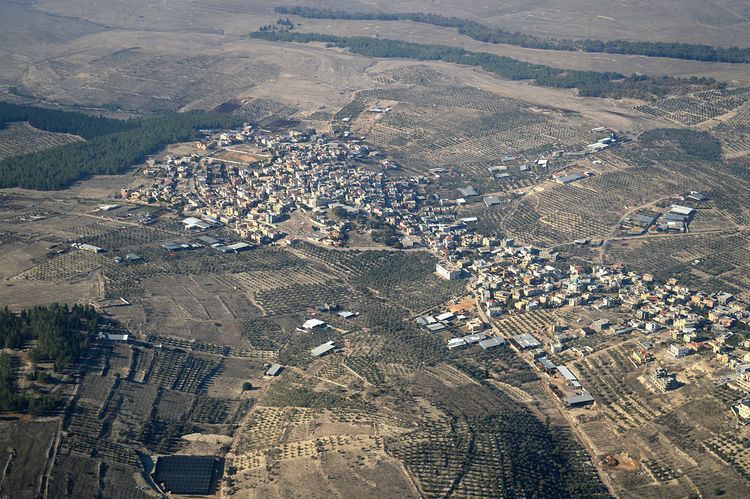Founded 19th century | ||
 | ||
Mu'awiya (Arabic: معاوية, Hebrew: מועאוויה) is an Arab village in Israel's Haifa District. The village is in the Wadi Ara area of the northern Triangle and lies between Kfar Kara and Umm el-Fahm. The village has around 3,100 residents. Since 1996, it has been under the jurisdiction of the Basma local council. The village is divided into two neighborhoods: eastern and western. The residents of the village belong to two clans: Ighbarieh and Mahmid.
Contents
History
Mu'awiya was established in the mid 19th century by villagers from nearby Umm El-Fahm. The village was named after a sheikh called Mu'awiya, whose tomb lies between the two parts of the village.
In the 1931 census Mu'awiya had 141 people in 30 houses and in the 1945 census the population of Mu'awiya was counted with that of Umm al-Fahm.
During the 1948 Arab-Israeli War the village and the surrounding area came under Iraqi control. In March 1949 Jordanian forces replaced the Iraqi forces in Wadi Ara. During the war refugees from the villages of Sabbarin, Khubbayza, Al-Kafrayn and Al-Butaymat setteled in the village. On 3 April 1949 Israel and Jordan signed the 1949 Armistice Agreements, in which Israel would receive the Wadi Ara area. On 20 April 1949, Mu'awiya was taken by Israeli forces and was later annexed to Israel along with the rest of the Wadi Ara villages. The Israeli army ordered the 500 residents to leave the village for a few hours, but then demolished the entire village. The villagers appealed the military governor of Umm El-Fahm, who said the action was illegal and that he will bring the matter to the Knesset. Eventually the villagers were allowed to return in mid 1950 but they received no compensation and much of the village land was confiscated. Many villagers suffered from confiscation many agricultural lands and had to find work outside of the village. Most of the agricultural lands were converted to olive trees.
In 1995 the village was united with Ein as-Sahala and Barta'a west, and in 1996 the Basma local council to administer the three villages.
Geography
Mu'awiya lies between the Barkan and Panther rivers and is divided into two parts: Mu'awiya on the east, and Khirbet Mu'awiya on the west. Between the village's parts lies the shrine of Sheikh Mua'wiya and next to them there are several hundred year old oak trees, that were preserved by the locals because of the sanctity of the site.
Andrew Petersen, an archaeologist specialising in Islamic architecture, surveyed the ancient shrine at Mu'awiya in 1994. According to local tradition, Muawiya had been a soldier in the army of Saladin. He had been killed in a battle close by the village, and he and twelve of his men were buried here. The shrine, named Shaykh Muawiya, is a domed square building, with the entrance to the north. The floor of the shrine is about 0,3 meters below the surface, and contain a cenotaph, incorporating marble columns. There is a mihrab in the wall to the south, just behind the cenotaph, and the west wall has a window. According to local tradition the shrine was built about 100 years ago. However, Petersen found that the structure itself suggested it was considerably older, with rebuilding in the late nineteenth century.
Education
Mu'awiya has one high school with over 700 students, an elementary school with over 400 students and eight kindergartens
Sports
Mu'awiya has a local football club called "Hapoel Mu'awiya Ironi" with a youth team participating in Noar Alef League, which is the second tier out of four. The team hosts matches in a football field located in Barta'a.
